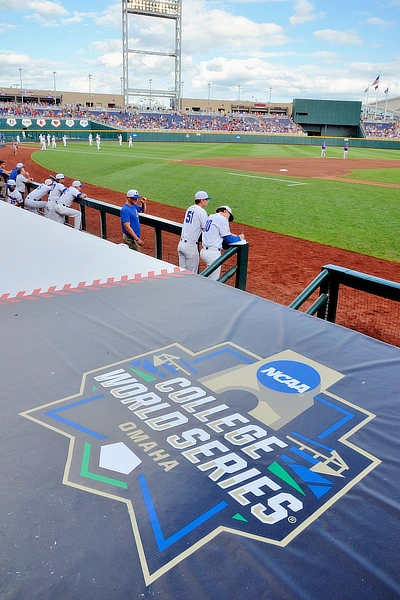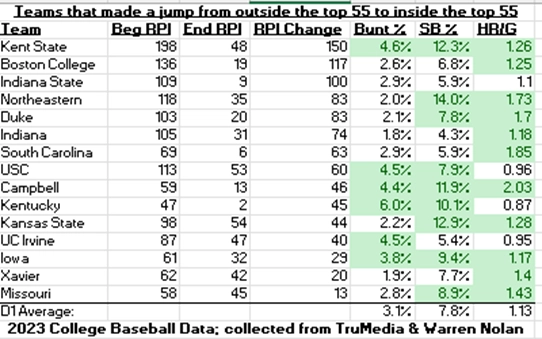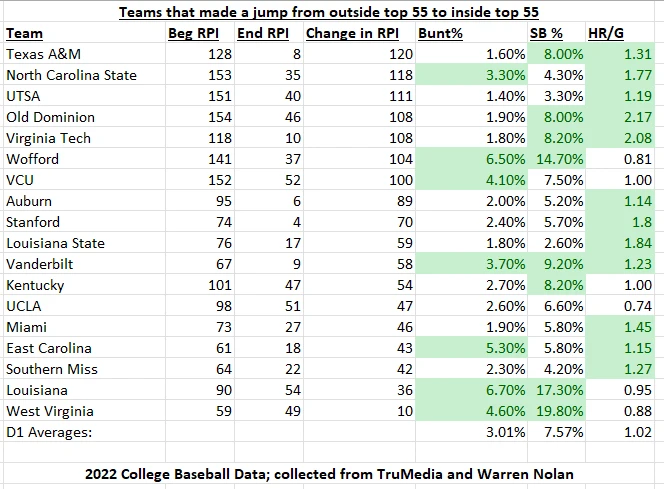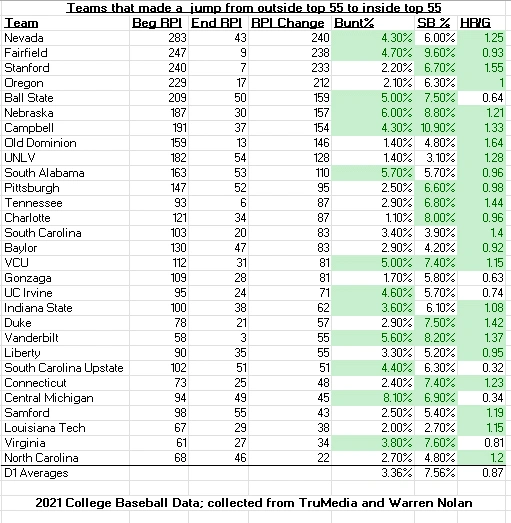
College World Series (2017) by jpellgen is licensed under CC BY-SA 2.0
The Ratings Percentage Index (RPI) is generally known to dictate which college baseball teams qualify for the NCAA tournament, but how can different strategies affect a teams’ RPI ranking?
With the beginning of the 2024 college baseball season on the horizon, teams are returning to the field after a seven-month hiatus from baseball. Following the conclusion of the 2023 World Series, which showcased a matchup of the power-hitting Texas Rangers and the small-ball Arizona Diamondbacks (view analysis), I was intrigued to study small-ball tactics in college baseball.
Similar to Major League Baseball, powerhouse programs often utilize extraordinary resources to recruit top-tier talent, provide world-class facilities, and construct impressive teams. Without similar funding and resource allocation, smaller Division 1 colleges often face challenges in competing with these programs. For consistently strong programs, such as LSU and Florida, their power-hitting and elite pitching staffs are obvious sources of success. LSU’s dominant pitching staff and Florida’s powerful hitting lineup this past season positioned them well to advance through the NCAA tournament and compete in the 2023 College World Series. But for some of the smaller D1 programs that struggle to recruit elite talent and lack comparable resources, they have to adapt to alternative strategic approaches and maximize the strengths of their rosters to be competitive against top programs. Several of these adaptive programs have found relief in embracing small-ball tactics,
Bunting and stealing tactics prove to be strategic tools that exploit specific matchups, capitalizing on the strengths and weaknesses of both the opposing pitcher and the defense of the opposing team. For instance, when facing a dominant pitcher with a high strikeout rate, a program can employ a bunting strategy to force the defense to make a play. Similarly, exploiting an opposing catcher with a weak arm through stolen bases becomes a strong weapon in generating more scoring opportunities. By analyzing these matchups and adjusting their strategy, smaller programs can gain a competitive edge over their more dominant counterparts.
Constructing a Stud
In the complex world of college athletics, the Rating Percentage Index (RPI) assumes a pivotal role in measuring a team’s overall performance. Widely used across various college sports, the RPI measures a team's strength of schedule and its ability to secure victories against different levels of competition. For college baseball, the NCAA tournament selection process heavily weighs RPI rankings, with teams within the top 55 generally considered contenders. As a result, aiming for a position within the top 55 RPI rankings becomes a crucial goal for college programs aspiring to make it into the NCAA tournament through the at-large process. With regard to the at-large selection process, a variety of factors are considered, including strength of schedule, strength of record, runs scored and runs allowed as well as many other factors.
Results
When assessing the impact of small-ball tactics in college baseball, the main objective was to analyze the change in RPI for Division 1 teams while examining their bunt (Bunt %) and stolen base (SB%) percentages as well as their number of home runs per game (HR/G). I wanted to see if a relationship exists between any of those strategies (small-ball or power-hitting) and a positive change in RPI. For the 2023 college baseball season, when looking at the teams that started the season outside the top 55 in RPI rankings and finished the season inside the top 55, ten out of the sixteen teams that made that “jump” into the top 55 at the end of the season were above average in bunt percentage and/or stolen base percentage, as shown in the chart below.

Table 1: 2023 College Baseball Data
The averages for bunt percentage and stolen base percentage across all Division 1 baseball are 3.1% and 7.8% respectively, and every team that had a bunt percentage above 3.1% or a stolen base percentage above 7.8% is highlighted in green. Likewise, the average for home runs per game was 1.13, and every team that averaged more than 1.13 home runs per game is highlighted in green. As you can see in Table 1, home runs clearly play a huge part in generating runs and increasing a team’s RPI ranking, but this chart suggests that the teams that make the significant jumps in RPI rankings are the more “well-rounded” teams, often employing some sort of small-ball tactics in addition to their power-hitting approach. Take Kent State as an example: they jumped 150 spots in the RPI rankings from 198 at the beginning of the season to 48 at the end, and they were above average in all three statistics of Bunt %, SB %, and HR/G. Kent State is a prime example of a well-rounded team that employed a combination of small-ball tactics and power-hitting dominance to increase its RPI ranking.
Other teams like Iowa or Northeastern or Campbell – none of which would be classified as traditional powerhouse programs – also utilized a combination of bunting and stolen base tactics as well as power-hitting to increase their RPI ranking over the course of the 2023 season and set themselves up to make the NCAA tournament (in fact, Indiana State, Campbell, Iowa, and Northeastern all made the NCAA tournament).
By expanding the sample to analyze the 2022 and 2021 college baseball seasons, we see that the 2023 data resembles the patterns observed in 2022 and 2021. In both instances, programs employing bunting and stealing tactics showcased a positive relationship with a positive trajectory in RPI rankings. In the 2022 season (shown in Table 2), nine out of the eighteen teams making the leap from outside the top 55 in RPI to inside it exhibited above-average bunt or stolen base percentages. Teams like Wofford and Louisiana, classified as smaller Division 1 programs, strategically leveraged small-ball tactics to elevate their RPI to be considered as among the elite programs in college baseball.

Table 2: 2022 College Baseball Data
Just like in 2023, the well-rounded teams that can utilize both small-ball tactics as well as power-hitting strategies are the teams that jumped into the top 55 RPI rankings. In 2022, the averages for bunt percentage and stolen base percentage across all Division 1 baseball are 3.01% and 7.57% respectively, and every team that had a bunt percentage above 3.01% or a stolen base percentage above 7.57% is highlighted in green in the chart above. The average for home runs per game was 1.02, and every team that averaged more than 1.02 home runs per game is also highlighted in green. As mentioned earlier, home runs play a huge part in generating runs and increasing a team’s RPI ranking, but this chart proves that over the past couple years (2021 to 2023), the teams that make the jump in RPI rankings are the more well-rounded teams, often employing some sort of small-ball tactics in addition to their power-hitting approach. For the 2022 sample, there are teams like Louisiana, VCU, and East Carolina that utilized their expertise in bunting and stealing bases to improve their RPI and qualify for the NCAA tournament.

Table 3: 2021 College Baseball Data
We see the same trend when analyzing the 2021 season as well. A majority of the teams that jumped from outside the top 55 in RPI to inside the top 55 over the course of the season had a HR/G statistic that was above the Division 1 average of 0.87. However, teams like Fairfield, Campbell and VCU were ranked above average in both bunt percentage and stolen base percentage and were able to improve their RPI ranking and qualify for the NCAA tournament.
When analyzing the past three seasons, certain discernible trends have captured my attention. Primarily, the number of teams that jumped from outside the top 55 to inside the top 55 decreased from 2021 to 2023, as you can see by the fewer rows in Table 1 than in Table 3. Concurrently, the Division 1 averages for both stolen base percentage (SB%) and home runs per game (HR/G) increased from 2021 to 2023, showing a trend of strategic stealing as well as a focus on power-centric batting lineups.
Conclusion
While Florida, LSU and other premier programs in college baseball continue to dominate with their power-hitting and deep pockets, smaller programs have demonstrated that small-ball tactics can be a well-rounded approach to improve their RPI ranking. Small-ball tactics offer a way to level the playing field, maximize limited resources, put pressure on the opposition, exploit matchup opportunities, adapt to the changing nature of the game, and thrive on the big stage. Small ball can help smaller programs not only compete but also excel in college baseball.
About the Author

